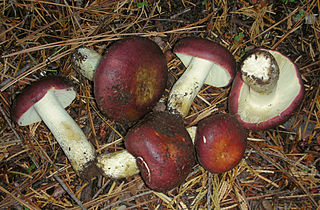
Russula xerampelina, also commonly known as the shrimp russula, crab brittlegill, or shrimp mushroom, is a basidiomycete mushroom of the brittlegill genus Russula. Two subspecies are recognised. The fruiting bodies appear in coniferous woodlands in autumn in northern Europe and North America. Their caps are coloured various shades of wine-red, purple to green. Mild tasting and edible, it is one of the most highly regarded brittlegills for the table. It is also notable for smelling of shellfish or crab when fresh.

Russula vesca, known by the common names of bare-toothed Russula or the flirt, is a basidiomycete mushroom of the genus Russula.

Russula virescens is a basidiomycete mushroom of the genus Russula, and is commonly known as the green-cracking russula, the quilted green russula, or the green brittlegill. It can be recognized by its distinctive pale green cap that measures up to 15 cm (6 in) in diameter, the surface of which is covered with darker green angular patches. It has crowded white gills, and a firm, white stipe that is up to 8 cm (3 in) tall and 4 cm (1.6 in) thick. Considered to be one of the best edible mushrooms of the genus Russula, it is especially popular in Spain and China. With a taste that is described variously as mild, nutty, fruity, or sweet, it is cooked by grilling, frying, sautéeing, or eaten raw. Mushrooms are rich in carbohydrates and proteins, with a low fat content.

Russula cyanoxantha, commonly known as the charcoal burner or variegated russula, is a basidiomycete mushroom, distinguished from most other members of the genus Russula by the fact that its gills do not split, but are soft and flexible. It is one of the most common species of Russula in Europe.

Russula claroflava, commonly known as the yellow russula, yellow swamp russula or yellow swamp brittlegill, is a basidiomycete mushroom of the genus Russula. It is found in wet places under birch and aspen woodlands across Europe and North America. It has a yellow cap, white gills and stipe and bruises grey. It is mild-tasting and regarded as good to eat.
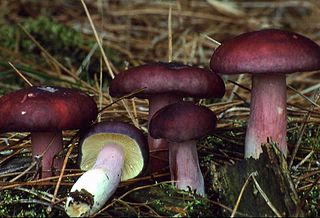
Russula sardonia, commonly known as the primrose brittlegill, is a mushroom of the genus Russula, which are commonly known as brittlegills. The fruiting body, or mushroom, is a reddish-purple, the colour of blackberry juice, and is found in coniferous woodland in summer and autumn. It is inedible, and like many inedible members of the genus, has a hot, peppery taste.

Russula adusta, commonly known as the blackening brittlegill or blackening russula, is a species of gilled mushroom. It is found in woodlands of Europe and North America. Russula adusta is a member of the Russula subgenus Compactae. The cap is brown to gray and somewhat shiny, with a mild taste and, reportedly, an odor of empty wine barrels. It has a propensity to turn black from cutting or bruising and has white spores. It can be found growing with conifers. Similar species include Russula albonigra and R. densifolia.

Russula sanguinaria, commonly known as the bloody brittlegill or rosey russula, is a strikingly coloured mushroom of the genus Russula, which has the common name of brittlegills. It is bright blood-red, inedible, and grows in association with coniferous trees. It was previously widely known as Russula sanguinea.
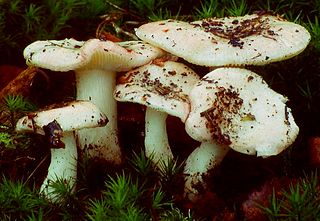
Russula betularum is a small, very pale member of the Russula (brittlegills) genus of mushrooms. It is usually white to very pale pink, inedible, and grows with birch trees. It is commonly known as the birch brittlegill.

Russula brevipes is a species of mushroom commonly known as the short-stemmed russula or the stubby brittlegill. It is widespread in North America, and was reported from Pakistan in 2006. The fungus grows in a mycorrhizal association with trees from several genera, including fir, spruce, Douglas-fir, and hemlock. Fruit bodies are white and large, with convex to funnel-shaped caps measuring 7–30 cm (3–12 in) wide set atop a thick stipe up to 8 cm (3 in) long. The gills on the cap underside are closely spaced and sometimes have a faint bluish tint. Spores are roughly spherical, and have a network-like surface dotted with warts.
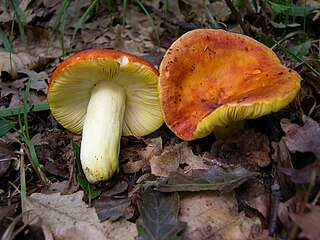
Russula aurea, commonly known as the gilded brittlegill, is an uncommon species of mushroom found in deciduous woodland in Europe in summer and early autumn. Unlike many red-capped members of the genus, it is edible and mild-tasting.
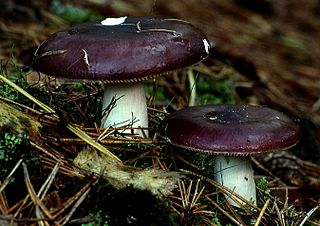
Russula caerulea, commonly known as the humpback brittlegill, is a member of the genus Russula, whose members are also known as brittlegills. It is a dark vinaceous or purple-colored edible mushroom, and grows with coniferous trees in late summer and autumn. It is found in Europe and North America.

Russula atropurpurea is an edible member of the genus Russula. It is dark vinaceous or purple, and grows with deciduous, or occasionally coniferous trees. It is commonly called the blackish purple Russula, or the purple brittlegill.

Russula delica is a mushroom that goes by the common name of milk-white brittlegill, and is a member of the genus Russula, all of which are collectively known as brittlegills. It is mostly white, with ochraceous or brownish cap markings, and a short robust stem. It is edible, but poor in taste, and grows in coniferous, broadleaved, or mixed woods. It can be confused with other white Russula species and certain white Lactarius species.

Russula fragilis, commonly known as the fragile russula, or fragile brittlegill, is a species of mushroom of the genus Russula, whose members are commonly known as brittlegills. It is a small, fragile, long stemmed, and variably coloured brittlegill, found in mixed forests, and woods in Europe, Asia, and North America.
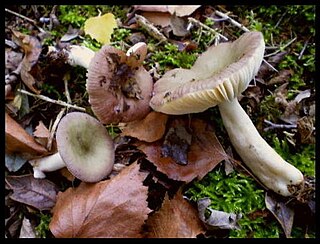
The mushroom Russula gracillima, commonly known as the slender brittlegill, is a member of the genus Russula, whose members are commonly known as brittlegills. It is a small, pale, long stemmed brittlegill associated mainly with birch and is occasional in Europe, Asia, and North America.

Russula albidula is a species of mushroom in the genus Russula. The species, known in the vernacular as the boring white russula or the whitish brittlegill, is nondescript, with a small or medium dirty white fruit body, and a highly acrid taste. It is found in eastern North America.
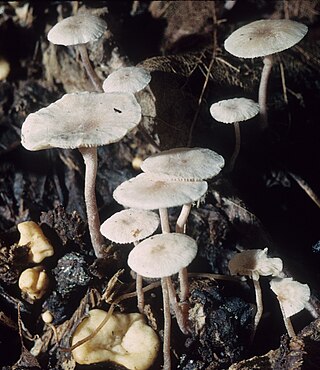
Collybia cookei is a species of fungus in the family Tricholomataceae, and one of three species in the genus Collybia. It is known from Europe, Asia, and North America. The fungus produces fruit bodies that usually grow on the decomposing remains of other mushrooms, like Meripilus giganteus, Inonotus hispidus, or species of Russula; occasionally fruit bodies are found on rich humus or well-decayed wood. The fungus produces small white mushrooms with caps up to 9 mm (0.35 in) in diameter, supported by thin stems that originate from a yellowish-brown sclerotium. The mushroom is difficult to distinguish from the other two species of Collybia unless an effort is made to examine the sclerotia, which is usually buried in the substrate. The edibility of the mushroom has not been determined.

Russula crustosa, commonly known as the crusty russula, is a species of fungus in the family Russulaceae. It is found in Asia and North America.
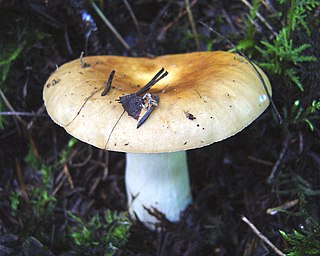
Russula mustelina, commonly known as the russet brittlegill, is a basidiomycete mushroom of the genus Russula native to Europe and North America. Swedish mycologist Elias Magnus Fries described the species in his 1838 book Epicrisis Systematis Mycologici seu Synopsis Hymenomycetum.




















